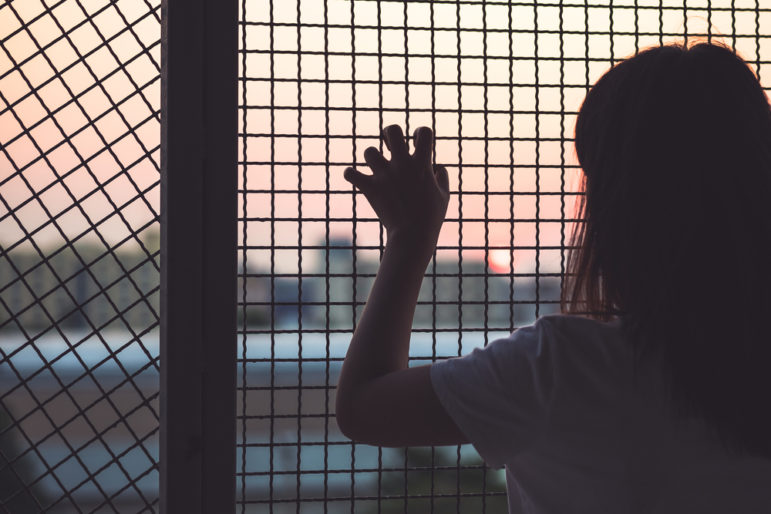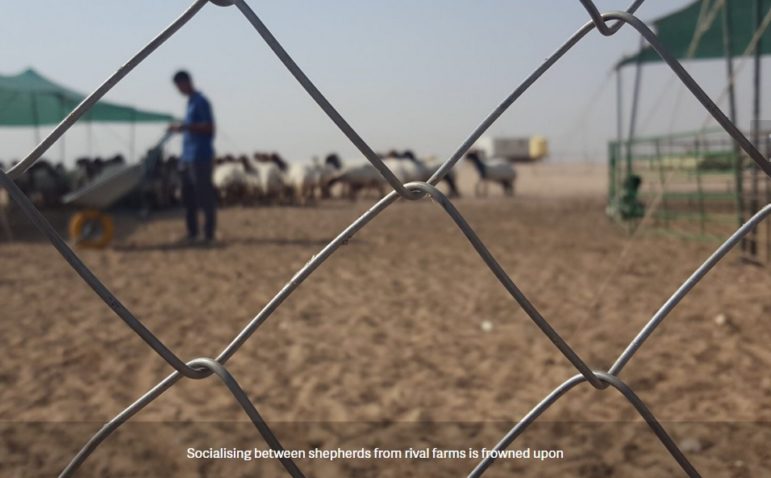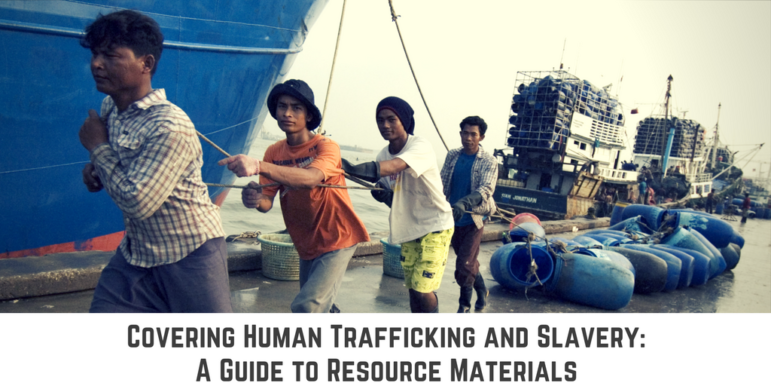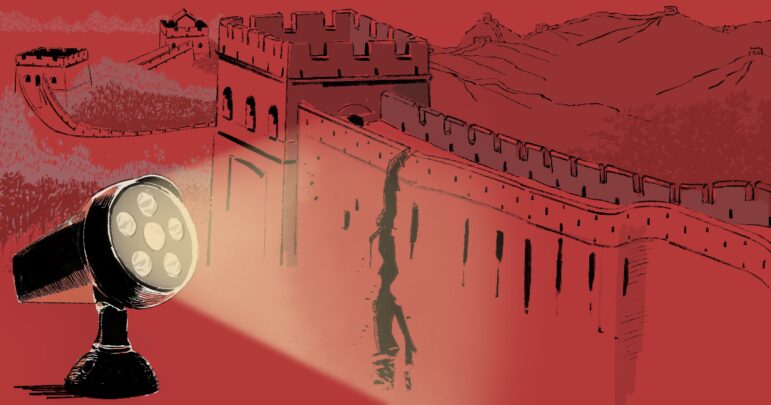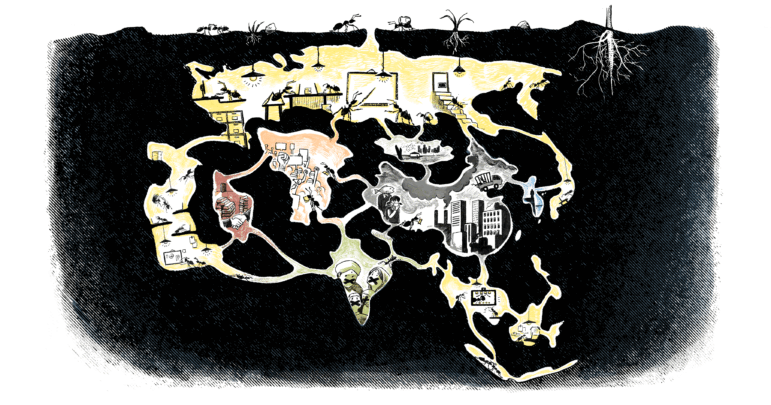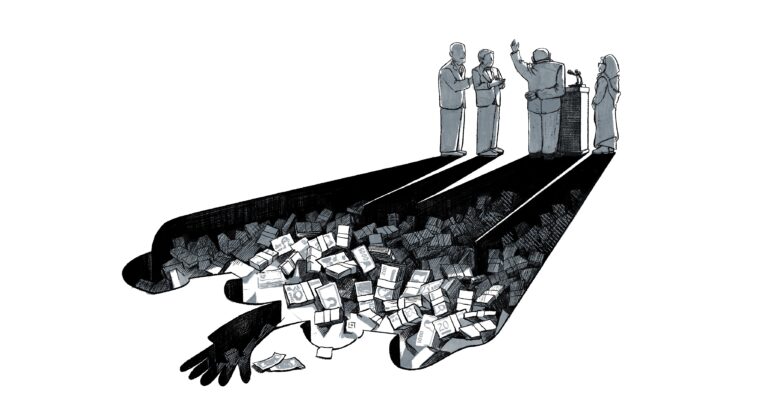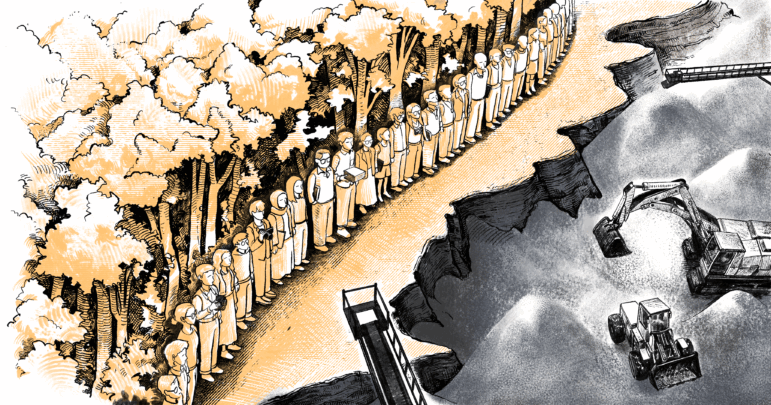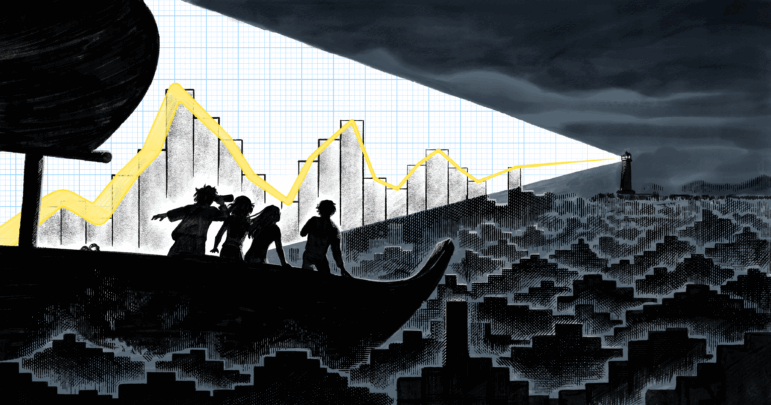

Illustration: Nyuk for GIJN
‘A Global Transit Point’: Investigating Human Trafficking and People Smuggling in South Asia
Read this article in
South Asia is a major origin, transit, and destination point for internal and transnational human trafficking and smuggling, due to the region’s porous borders, high rates of poverty and unemployment, and weak law enforcement.
Since 2010, the issue has been exacerbated by wars, political violence, and instability in Afghanistan, Syria and Libya, which have transformed trafficking routes. Economic migrants have merged with refugees fleeing conflict and persecution, and the numbers have risen since the COVID-19 pandemic and widespread job losses.
Recent data from the UN’s International Organization for Migration (IOM) shows that 2024 was Asia’s deadliest year for migrants, with at least 2,514 lives lost. Most of the surge in fatalities involved Rohingya Muslims fleeing persecution in Myanmar, and Afghans escaping ongoing regional instability and repression.
Though often conflated in media reports and policy discussions, human trafficking and human smuggling are distinct but interconnected crimes. Human trafficking aims to exploit and involves the recruitment and transportation of persons through force, coercion, or deception, for sexual exploitation or forced labor; women and children make up the majority of victims. People or human smuggling aims to make a profit off those who want to migrate, often by providing or promising passage or false documents. There are many overlapping issues, such as push factors (conflict, persecution, and poverty), survivors’ experiences, and migration routes. People are often victims of both.
In South Asia, common migration routes include internal, such as from rural to wealthier states and cities; cross-border, like from Bangladesh to India; or transnational, for instance, to Europe through Iran and Turkey or from North Africa over the Mediterranean Sea, or from the Bay of Bengal to Southeast Asia. The Gulf States are a significant destination, both for legal work and trafficked persons, and are also a transit stop on the way to Southeast Asia.
Investigative journalists in the region have discovered that smuggling networks often start with local recruiters — who can be friends and neighbors — and expand into organized syndicates that operate across borders, using forged documents and employment contracts, often with the support of border guards, embassy personnel, or other officials.
GIJN spoke with journalists and experts who have covered these issues from Pakistan, Bangladesh, and India, who have spent years building contacts; sat down with trafficking survivors, the agents that recruit them, and middlemen; mapped smuggling routes and logistics; and posed undercover as Afghan migrants to report on one of the fastest-growing transnational organized crimes.
Pakistan
Pakistan is both a source and transit country for trafficking and smuggling; for example, it’s an important route for migrants from Afghanistan, who cross through the border between the sparsely populated southwestern province of Balochistan and Iran on a long journey to the Balkans region. Two investigations highlight the dangers of this route and the reasons people attempt it.
The ‘Dunki’ Route
Journalist Sahar Baloch’s 2023 story, Quetta: How People Are Smuggled Into Europe, features an interview with an “agent” involved in transporting people through the province.
During lockdown in 2020, Baloch, then a broadcast journalist with BBC Urdu in Islamabad, was working on audio reports on the smuggling of petrol and food items through the Iran-Pakistan border in Balochistan, and kept hearing about how human traffickers were using the same trails to smuggle migrants out of the country, in what is colloquially known as the “dunki” (donkey) route to Europe via the Middle East.
Then, in February 2023, a migrant boat carrying 200 people capsized off the coast of Italy, killing 94 passengers, including Pakistani-Hazara hockey player Shahida Raza, who had left Balochistan in search of medical treatment for her three-year-old son.
While working on a video about Raza, Baloch searched through social media sites, looking for any information she could find on human traffickers. “I was going through TikTok and Facebook and came across so many accounts of ‘agents’ offering ‘VIP packages’ to take people to Iran, Turkey, Greece, etc.,” Baloch explains.
“All this was happening openly, and it was being publicized as an ‘adventure,’” she adds. “Some migrants would upload celebratory videos of themselves upon reaching Europe, thanking their ‘brother’ (the agent), so that got me wondering: Who are these agents?”
She got in touch with one agent who said he was in Belgium (“his number was on his page; it wasn’t like he was trying to hide”), and posed as someone looking to migrate to Europe. He told her to get to Quetta, the provincial capital in Balochistan, because his “services” only began there — and to bring money.
Right before she reached Quetta, however, she called the agent and blurted out the truth: that she was a journalist working on a story on human trafficking. He hung up. “Everyone [around me] laughed and said: ‘Why would anyone speak to you?’ That led to what she calls one of the most interesting, but unsettling interviews of her career.
She had only two days left in Quetta to find a story, so she contacted an old source who connected her with an “agent” in Panjpai: a vast and barren stretch of land about 50-55 kilometers (31-34 miles) outside of Quetta. She had doubts about the interview but arrived with a driver and video journalist Khair Muhammad, both of whom spoke Brahui (one of the languages spoken in Balochistan).
To her surprise, the agent, whose face was concealed in the video, spoke openly and casually about how migrants were packed into “cage-like” vans, and that buses full of people were auctioned off among agents in places like Quetta and Machh. He also spoke about how some ethnic groups, like Hazaras, who were fleeing for security reasons, were charged more compared to Punjabis; how some passengers would agree to being crammed into the trunk of the buses; and how much the agents would need to pay off paramilitary officers at the border guards, anything from 5,000 rupees (US$56), if he happened to be from the same village, to 30,000 rupees (US$338), if he was an outsider.
“Some people would die before they even reached the border, just drop dead [from thirst and exhaustion], because Balochistan is tough; there aren’t many roads or facilities,” Baloch explains. “It’s an intimidating landscape.”
‘A Vast Racket’
Muhammad Akbar Notezai, from the daily newspaper Dawn, has also investigated this trafficking route, examining other dangers like thieves who steal from passengers at gunpoint, and the risk of being shot at by Iranian border guards. For an exposé, he went undercover posing as an Afghan migrant, traveling from Duk, on the Balochistan-Afghanistan border, to Iran in a pickup truck.

Reporter Muhammad Akbar Notezai went undercover to understand the human smuggling trade between Afghanistan and Iran. Image: Screenshot, Dawn
“I didn’t tell anyone, not even my family,” he tells GIJN. The only person who knew was a source who had helped connect him to a trafficker. “If anything were to happen to me, he was to inform my family and colleagues at Dawn.”
Originally from the Chaghai district, on the Balochistan-Iran border, Akbar had previously reported on human trafficking for Dawn Investigations in 2018, interviewing FIA [security agency] officials, migrants, and their families. He focused mainly on Afghan migrants fleeing war and political instability, and economic migrants from the small towns of Punjab.
“In Punjab, there’s this idea in their mind that Europe is better,” says Akbar, who refers to these migrants as “dream chasers” in his article. “I told them I only have a pen and paper, no camera, so they opened up to me.” That reporting laid the groundwork for his undercover investigation years later.
To prepare, he made trips to all the sites he would eventually have to pass through on the way to the border, traveling to places 500-700 kilometers (310-435 miles) away from Quetta, changing his phone and SIM card so he couldn’t be tracked, and learning Dari to be more convincing in his role. “I saw it as a public service, which kept me motivated despite the risks,” he says.
“Most people didn’t know much about human trafficking in Balochistan before 2018,” Akbar notes, even though the route is said to have been active since the 1970s, when Bengalis and Sri Lankans were fleeing conflict and persecution. “The reporting does make some difference. There are tighter restrictions for a while, but it’s such a vast racket that it’s hard to shut down completely.”
Bangladesh
For over a decade, Shariful Islam Hasan covered some of Bangladesh’s most pressing issues, including migration and human trafficking, for Prothom Alo, one of the country’s leading newspapers.
Some of the most unforgettable cases he encountered included Bangladeshi migrants being tortured in Libya, or sold in Dubai, or sexually exploited in Saudi Arabia.
Since 2017, he’s been the associate director of the Migration and Youth Platform at Bangladesh Rural Advancement Committee (BRAC), one of the world’s largest NGOs.
“Presently, Bangladeshis form the largest group of migrants using the Central Mediterranean route to Europe via Libya,” he explains. In January, for instance, the bodies of 23 Bangladeshi nationals washed up on the Libyan shore after a migrant boat had set off for Italy a few days earlier.
“There are three or four layers in this trade,” adds Hasan. “The first is someone from within the local community, who deceives victims of a dream life in Europe. They tell people they can go to Europe on a big boat. But then they reach Libya, are kept as hostages, tortured, and their families are asked for ransom. If families aren’t able to pay, they get killed. The international traffickers are never arrested.”
“When I started [covering these issues], there were no laws or rules,” he points out. “It was only after mass graves of Rohingya were discovered between 2012 and 2015 that the government started looking into how to combat illegal routes from the Bay of Bengal to Thailand, Indonesia, Malaysia, etc.”
Since 2012, Bangladesh has passed two major laws aimed at curbing the practice. This legislation criminalizes all forms of human trafficking, while also providing rehabilitation for victims.
India
India’s Northeast region shares international borders with Nepal, Bhutan, China, Bangladesh, and Myanmar, where the state of Assam, in particular, is one of the “major hotbeds for human trafficking,” says Pari Saikia, an independent journalist based in Delhi.
Originally from the area, Saikia has spent her entire career reporting on human trafficking in India, which she says is “a global transit, source and destination point” for the trade, besides the frequent domestic trafficking happening within its own borders, particularly of women and girls forced into labor or sexual exploitation.
She first encountered this issue as an aspiring young journalism student. Her father, a local police officer, suggested she meet some trafficking victims who had been rescued from abusive situations in Delhi and Noida, where they were sold by fake recruitment agencies to work as domestic helpers.
“There were 22 girls: some were as young as 12, 13, 14 years old, some had cigarette burn marks on their bodies, and several looked malnourished,” she recalls.
This became her first story, and she says it was a defining moment, though she admits she feels bittersweet looking back now. “When you report on an issue for a very long time, and you see the cycle repeating without much change, you ask yourself: What’s the point of investigating, if it doesn’t lead to anything?,” she says. “However, I refuse to give up.”
In 2024, she published a longform investigation recounting the harrowing 500-day journey of a migrant (‘Singh’) who was “once trafficked, twice smuggled” on his way from Indian Punjab to Portugal, which has become a common entry or destination point for many migrants from South Asia in recent years due to its less difficult residency process.
“With a Temporary Residence Card (TRC), migrants can travel through most of the Schengen region for short periods, creating a market for traffickers to illegally move people across borders into Italy, Germany, or Spain on false job promises,” Saikia explains. “People are told it will be easy. They aren’t warned about the long overland routes, the cold, the risks, or the fact that they’ll likely have to work illegally once they arrive, or pay extortion to stay alive.”
She was working on a series of articles on the lives of Punjabi women in Europe when she soon began receiving phone calls from migrants and their families — including ‘Singh,’ who said he was stranded in Cyprus after his passport had been confiscated by ‘donkers’ (colloquial term for traffickers).
He ended up on the Mediterranean island after transiting through Serbia — where Indians were allowed visa-free entry at the time. Many of the traffickers he encountered on his journey were South Asians operating small guesthouses and networks specifically for smuggling migrants. ‘Singh’ said his family had sold their land to pay his smugglers’ fees, and he refused to return home empty handed.

Indian journalist Pari Saikia tracked the 500-day migration journey of ‘Singh,’ whose smuggling journey traversed Asia and Europe. Image: Screenshot, Rural India online
“For three years, I followed his case,” Saikia recalls. “He told me he was moving from one country to another, and if I didn’t hear from him within 48 hours, I should alert the embassy.”
Traffickers market migration like a business. “They offer two packages: one for Europe and one for the United States,” she explained. “The European route costs less, while the US route can go up to 60 lakh rupees (US$68,000).”
Even as more reports surface about boats sinking in the Mediterranean or migrants dying along overland routes, recruitment and trafficking networks across Asia continue to adapt, using social media, fake recruitment agencies, and word-of-mouth promises.
“The traffickers know exactly what people want to hear,” she notes. “They sell hope. And hope is hard to resist when opportunities at home are so limited.”
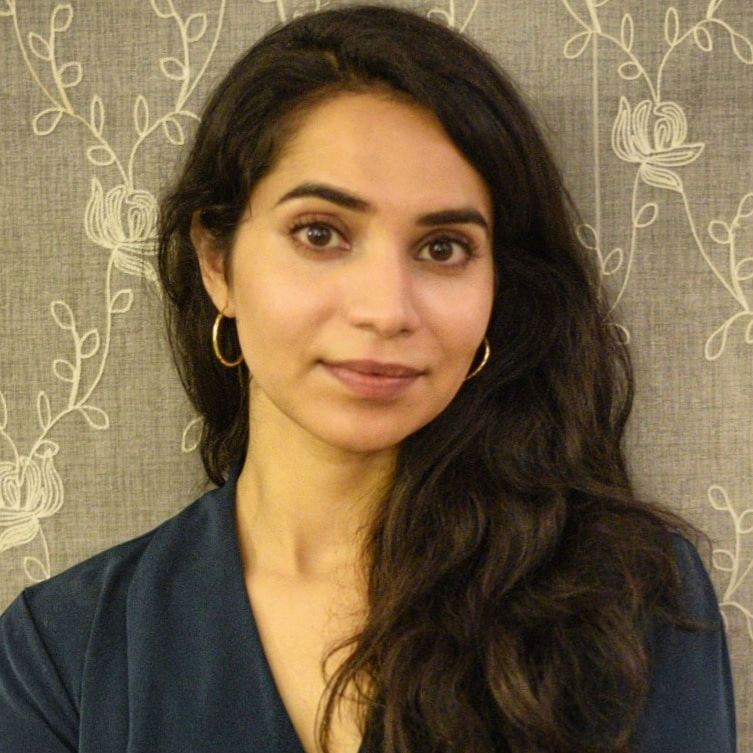 Sama Faruqi is a freelance journalist based in Karachi, Pakistan.
Sama Faruqi is a freelance journalist based in Karachi, Pakistan.
Illustration: Nyuk was born in 2000 in South Korea. He is currently studying at the Department of Applied Art Education at Hanyang University in Seoul, where he also works as an illustrator. Since the exhibition at Hidden Place in 2021, he has participated in various illustration exhibitions. He is mainly interested in hand drawing, which represents the value of his art world.

